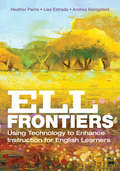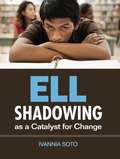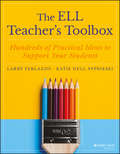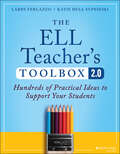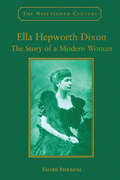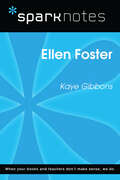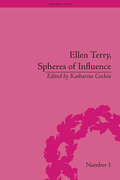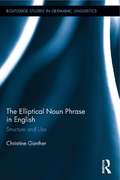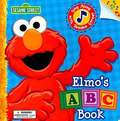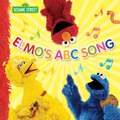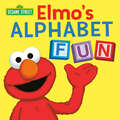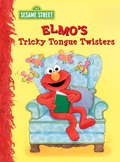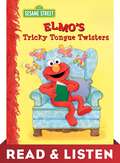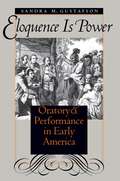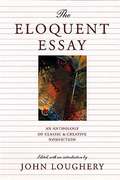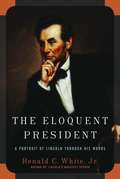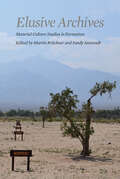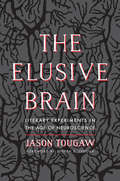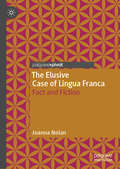- Table View
- List View
ELL Frontiers: Using Technology to Enhance Instruction for English Learners
by Andrea M. Honigsfeld Heather Parris Lisa M. EstradaYour GPS for improving ELLs’ academic outcomes Grounded in the latest research on EL language and literacy development and technology integration, this timely book will serve as your road map for navigating the exciting new frontier of digital instruction. Learn how to improve academic outcomes, enhance language acquisition, and cultivate digital citizenship through ELL Frontiers’: An overview of current digital age learning experiences and trends Step-by-step guides to implementing technology-infused lessons that are specifically adapted for English learners, including a sample lesson seed in each chapter Authentic vignettes of current uses of technology in the classroom Professional Learning Network questions for group discussion
ELL Shadowing as a Catalyst for Change
by Ivannia M. SotoExperience a day in the life of an ELL What if you could barely understand what your teacher was saying? ELL shadowing helps teachers experience the classroom from the student’s point of view. The author describes how to implement this easily accessible form of professional development, outlines specific strategies for adapting instruction to engage ELLs, and provides supporting videos on a companion website. Benefits include: Increased teacher sensitivity to ELLs’ school experiences A heightened sense of urgency to help ELLs learn academic language and content Improved classroom instruction that spreads throughout schools and districts More engaged students who are more likely to stay in school and reach their potential
The ELL Teacher's Toolbox: Hundreds of Practical Ideas to Support Your Students (The Teacher's Toolbox Series)
by Larry Ferlazzo Katie Hull SypnieskiPractical strategies to support your English language learners The ELL Teacher’s Toolbox is a practical, valuable resource to be used by teachers of English Language Learners, in teacher education credential programs, and by staff development professionals and coaches. It provides hundreds of innovative and research-based instructional strategies you can use to support all levels of English Language Learners. Written by proven authors in the field, the book is divided into two main sections: Reading/Writing and Speaking/Listening. Each of those sections includes “Top Ten” favorites and between 40 and 70 strategies that can be used as part of multiple lessons and across content areas. Contains 60% new strategies Features ready-to-use lesson plans Includes reproducible handouts Offers technology integration ideas The percentage of public school students in the U.S. who are English language learners grows each year—and with this book, you’ll get a ton of fresh, innovative strategies to add to your teaching arsenal.
The ELL Teacher's Toolbox 2.0: Hundreds of Practical Ideas to Support Your Students (The Teacher's Toolbox Series)
by Larry Ferlazzo Katie Hull SypnieskiSet your English language learners up for success with this effective resource The ELL Teacher's Toolbox 2.0 is a valuable, updated resource that teachers of English Language Learners (ELLs) can use to improve student outcomes. With hundreds of innovative strategies and activities to bring to your classroom, this book can be used with learners of all levels and in any instructional setting. This revised edition provides the latest enhancements to the instructional tools—along with 16 new chapters that you can add to your teaching repertoire. New content includes coverage of artificial intelligence, online learning environments, and differentiated instruction. Graphics and visuals make it easy to understand and adapt the content to your unique teaching situation. Written by proven authors in the field, the book is divided into two main sections: Reading/Writing and Speaking/Listening. Each of those sections includes “Top Ten” favorites and between 40 and 70 strategies that can be used as part of multiple lessons and across content areas. Contains 60% new strategies Features ready-to-use lesson plans Includes reproducible handouts Offers technology integration ideas For the growing number of ELLs in public schools, effective ELL instruction can mean the difference between long-term academic success and continued struggling. In this book, you'll find countless practical ideas to add to your teaching arsenal—or for training and coaching ELL teachers—so you can support your students on their journey.
Ella Baker's Catalytic Leadership: A Primer on Community Engagement and Communication for Social Justice (Communication for Social Justice Activism #2)
by Patricia S. ParkerElla Baker (1903–1986) was an influential African American civil rights and human rights activist. For five decades, she worked behind the scenes with people in vulnerable communities to catalyze social justice leadership. Her steadfast belief in the power of ordinary people to create change continues to inspire social justice activists around the world. This book describes a case study that translates Ella Baker’s community engagement philosophy into a catalytic leadership praxis, which others can adapt for their work. Catalytic leadership is a concrete set of communication practices for social justice leadership produced in equitable partnership with, instead of on, communities. The case centers the voices of African American teenage girls who were living in a segregated neighborhood of an affluent college town and became part of a small collective of college students, parents, university faculty, and community activists learning leadership in the spirit of Ella Baker.
Ella Hepworth Dixon: The Story of a Modern Woman (The Nineteenth Century Series)
by Valerie FehlbaumIn a career that spanned over forty years, Ella Hepworth Dixon (1857-1932) was alternately journalist, critic, essayist, short story writer, novelist, editor of a women's magazine, dramatist, and autobiographer. After an initial popularity, however, Ella Hepworth Dixon's work, like that of the majority of her contemporaries, remained largely unread for decades. In her new study, Valerie Fehlbaum sheds light on Dixon's life and work, and provides profound insight not only into Dixon herself but into the multifaceted character of the 'New Woman' writer that Dixon typified. The figure of the New Woman as representing new-found intellectual, social, and political freedom came to the fore towards the end of the nineteenth century when the term 'woman' was being interrogated on every imaginable level. In heated debates about woman's nature, primary questions such as 'what is a woman?' and 'what does a woman want?' were accompanied by subsidiary controversies about the precise role she should play in society. Fehlbaum's re-evaluation of Dixon's varied literary output enhances our understanding of this period of radical change for women, and shows that Ella Hepworth Dixon's writing remains as lively and pertinent today as it was when it was first published.
Ellen Foster (SparkNotes Literature Guide Series)
by SparkNotesEllen Foster (SparkNotes Literature Guide) by Kaye Gibbons Making the reading experience fun! Created by Harvard students for students everywhere, SparkNotes is a new breed of study guide: smarter, better, faster.Geared to what today's students need to know, SparkNotes provides:chapter-by-chapter analysis explanations of key themes, motifs, and symbols a review quiz and essay topics Lively and accessible, these guides are perfect for late-night studying and writing papers.
Ellen Terry, Spheres of Influence (Dramatic Lives #1)
by Katharine CockinIn this essay collection, established experts and new researchers, reassess the performances and cultural significance of Ellen Terry, her daughter Edith Craig (1869–1947) and her son Edward Gordon Craig (1872–1966), as well as Bram Stoker, Lewis Carroll and some less familiar figures.
Ellipsis in English Literature
by Anne TonerAnne Toner provides an original account of the history of ellipsis marks - dots, dashes and asterisks - in English literary writing. Highlighting ever-renewing interest in these forms of non-completion in literature, Toner demonstrates how writers have striven to get closer to the hesitancies and interruptions of spoken language, the indeterminacies of thought, and the successive or fragmented nature of experience by means of these textual symbols. While such punctuation marks may seem routine today, this book describes their emergence in early modern drama and examines the relationship between authors, printers and grammarians in advancing or obstructing the standardisation of the marks. Their development is explored through close study of the works of major English writers, including Jonson, Shakespeare, Richardson, Sterne, Meredith and Woolf, along with visual illustrations of their usage. In particular, Toner traces the evolution of ellipsis marks in the novel, a form highly receptive to elliptical punctuation.
The Elliptical Noun Phrase in English: Structure and Use (Routledge Studies in Germanic Linguistics)
by Christine GüntherThis book presents a detailed analysis of structural as well as pragmatic aspects underlying the phenomenon of noun ellipsis in English. Here Günther examines the structure of elliptical noun phrases to account for the conditions on noun ellipsis and those on one-insertion, with special emphasis on the (oft-neglected) parallels between the two. She also examines the use of noun ellipsis with adjectives in order to shed light on this under-researched phenomenon, drawing on data from the British National Corpus.
Ellmann's Joyce: The Biography of a Masterpiece and Its Maker
by Zachary LeaderThe story of the most acclaimed literary biography of the twentieth century—an ingeniously plotted, behind-the-scenes account of how the literary critic and scholar Richard Ellmann shaped James Joyce’s reputation.Richard Ellmann’s James Joyce, published in 1959, was hailed by Anthony Burgess as “the greatest literary biography of the twentieth century.” Frank Kermode thought the book would “fix Joyce’s image for a generation,” a prediction that was if anything too cautious. The biography won the National Book Award and durably secured Joyce’s standing as a preeminent modernist.Ellmann’s Joyce provides the biography of the biography, exploring how Ellmann came to his subject, gained the cooperation of Joyce’s family and estate, shrewdly, doggedly collected vital papers and interviews, placated publishers, thwarted competitors, and carefully balanced narrative with literary analysis. Ellmann’s Joyce also removes the veil from the biographer—richly rewarded in public, admirable in private life, but also possessed of a startling secret life. An eminent biographer himself, Zachary Leader constructs a powerful argument not only in support of Ellmann’s intellectual and artistic claims but also on behalf of literary biography generally. In the process, he takes readers on a rare tour through midcentury publishing houses in New York and London, as well as the corridors and classrooms of elite universities, from Yale to Oxford. The influence of Ellmann’s book, recognized instantly, persists to this day, among literary scholars and Joyce fans alike.Filled with surprising details, tales of intrigue from the heyday of literary publishing, and intimate portraits of the Joyce and Ellmann families, Ellmann’s Joyce is as immersive as a walk around town with Leopold Bloom and as moving as the thickly drifted snow on Michael Furey’s grave.
Elmore Leonard's 10 Rules of Writing
by Elmore Leonard"These are the rules I've picked up along the way to help me remain invisible when I'm writing a book, to help me show rather than tell what's taking place in the story."--Elmore LeonardFor aspiring writers and lovers of the written word, this concise guide breaks down the writing process with simplicity and clarity. From adjectives and exclamation points to dialect and hoopetedoodle, Elmore Leonard explains what to avoid, what to aspire to, and what to do when it sounds like "writing" (rewrite).Beautifully designed, filled with free-flowing, elegant illustrations and specially priced, Elmore Leonard's 10 Rules of Writing is the perfect writer's--and reader's--gift.
Elmo's ABC Book
by Sarah AlbeeElmo the little monster cannot decide which is his favorite letter of the alphabet, because he has favorite things for almost every letter.
Elmo's ABC Song (Pictureback(R))
by Random HouseElmo and his friends teach boys and girls ages 1 to 4 the letters of the alphabet in this Sesame Street storybook. Bright, crisp photographs showcase the Sesame Street characters, the letters from A to Z, and the many items that begin with each letter.
Elmo's Alphabet Fun (Pictureback(R))
by Jennifer LibertsIt's Alphabet Day at school, and Elmo is ready to learn his letters! This paperback picture book includes Sesame Street stickers for each letter of the alphabet!Elmo, Abby, Julia, and other Sesame Street friends are extra excited for school because today is Alphabet Day. Their preschool teacher has them singing the ABC song, decorating letters, and playing a fun alphabet game! Young children will love learning their letters with Elmo.Sesame Workshop, the nonprofit educational organization behind Sesame Street, aims to help kids grow smarter, stronger, and kinder through its many unique domestic and international initiatives. These projects cover a wide array of topics for families around the world. Sesame Street is the most trusted name in early learning.
Elmo's Tricky Tongue Twisters (Big Bird's Favorites Board Books)
by Sarah Albee Maggie SwansonPacked into the pages of this sturdy Sesame Street board book is a collection of tongue-tripping rhymes about everyone's favorite Sesame Street Muppets, including Elmo, Grover, Ernie, Bert, Betty Lou, Herry, Hoots the owl, and Oscar. The rhyming language and singsong rhythm of tongue twisters are key concepts in language development for babies and toddlers. The humor and playfulness of the tongue twisters in this collection will give toddlers a fun into into the world of wordplay, the foundation of a lifelong enjoyment of the written and spoken word. This book is ideal for use in pre-school classrooms as well as parent/child sharing.
Elmo's Tricky Tongue Twisters (Sesame Street): Read & Listen Edition
by Sarah AlbeePacked into the pages of this sturdy Sesame Street board book is a collection of tongue-tripping rhymes about everyone's favorite Sesame Street Muppets, including Elmo, Grover, Ernie, Bert, Betty Lou, Herry, Hoots the owl, and Oscar. The rhyming language and singsong rhythm of tongue twisters are key concepts in language development for babies and toddlers. The humor and playfulness of the tongue twisters in this collection will give toddlers a fun into into the world of wordplay, the foundation of a lifelong enjoyment of the written and spoken word. This book is ideal for use in pre-school classrooms as well as parent/child sharing.This Read & Listen edition contains audio narration.
Eloquence Is Power
by Sandra M. GustafsonOratory emerged as the first major form of verbal art in early America because, as John Quincy Adams observed in 1805, "eloquence was POWER." In this book, Sandra Gustafson examines the multiple traditions of sacred, diplomatic, and political speech that flourished in British America and the early republic from colonization through 1800. She demonstrates that, in the American crucible of cultures, contact and conflict among Europeans, native Americans, and Africans gave particular significance and complexity to the uses of the spoken word. Gustafson develops what she calls the performance semiotic of speech and text as a tool for comprehending the rich traditions of early American oratory. Embodied in the delivery of speeches, she argues, were complex projections of power and authenticity that were rooted in or challenged text-based claims of authority. Examining oratorical performances as varied as treaty negotiations between native and British Americans, the eloquence of evangelical women during the Great Awakening, and the founding fathers' debates over the Constitution, Gustafson explores how orators employed the shifting symbolism of speech and text to imbue their voices with power.
Eloquent Essay: An Anthology of Classic and Creative Nonfiction
by John LougheryA concise anthology of superb classic and creative nonfiction from the twentieth century.<P> This anthology of seventeen modern essays shows the form at its most varied and dramatic. Purposefully concise, it gathers together exemplars of the personal narrative, the argument, the anecdotal essay, digressive discourse, the "open letter," and others. Some of the most engaging authors of our time write on subjects as diverse as becoming a doctor, cattle grazing rights, the death of Socrates, Anne Frank, computer culture, and how to detect "baloney" in all the verbiage that surrounds us.<P> Included in the collection are essays by George Orwell, W. H. Auden, Bruno Bettelheim, Eudora Welty, Martin Luther King Jr., Joan Didion, Edward Abbey, Leo Marx, I. F. Stone, Pico Iyer, Amy Tan, Lewis Thomas, Barbara Kingsolver, Ann S. Causey, Carl Sagan, Ellen Ullman, and Opal Palmer Adisa. Arranged in chronological order, each selection begins with a note about the author and the essay that follows. The introduction discusses the history of the essay form and the reasons for its special vitality.<P> The Eloquent Essay engages the intellect and the passions, and offers the general reader the pleasures of cogent written discourse. At the same time, its carefully selected essays—each one superbly written and accessible—are well suited to study and discussion.
The Eloquent President: A Portrait of Lincoln Through His Words
by Ronald C. White Jr.Analysis of Lincoln's speeches and the events surrounding them.
The Elsewhere Community (The CBC Massey Lectures)
by Hugh KennerAcclaimed literary critic Hugh Kenner examines Western culture's insatiable need for stimulation encountered elsewhere - from the eighteenth century's Grand Tour, to the self-imposed exile of modernist writers, to the disembodied global journeys the Internet avails us today. Kenner brings to this fascinating study knowledge of a wide array of disciplines. Hugh Kenner has written on topics ranging from geodesic domes to Bugs Bunny, but is perhaps best known for The Pound Era, his definitive study of Ezra Pound's life and work.
ELT: The Basics (The Basics)
by Michael McCarthy Steve WalshELT: The Basics offers a clear, non-jargonistic introduction to English language teaching for EFL/ESL teachers in training, early career teachers, those considering taking up ELT, and experienced teachers who may want to read about the way the profession has developed and continues to evolve. Key features of this book include: Real classroom data and data from ELT training programmes Discussion of a wide range of learning contexts and different types of learners (young learners, adults, third age, academic, refugees and immigrants, etc.) Comparisons of different types of syllabuses and methods, and discussion of current technologies An emphasis on classroom interaction as the key to maximising learning Featuring a glossary of key terms, cartoons and illustrations, further reading, personal reflection points, and discussion of the most important and relevant research, this book is a clear and accessible introduction to the complex field of ELT.
Elusive Archives: Material Culture in Formation (Material Culture Perspectives)
by Julian Yates Wendy Bellion Julie L. McGee Torsten Cress Cindy Ott Laura E. Helton Jennifer Van Horn Kiersten Thamm Alexandra Ward Alexander Lawrence Ames Halina Adams Rosalie Hooper Sarah Wasserman Spencer Wigmore Catherine Morrissey Michelle Everidge Kaila T. Schedeen Lu Ann Cunzo Natalie Elizabeth Wright Oliver Scheiding J. Ritchie Garrison Jesse Kraft Michael J. Emmons Jessica Conrad Bernard L. HermanThe essays that comprise Elusive Archives raise a common question: how do we study material culture when the objects of study are transient, evanescent, dispersed or subjective? Such things resist the taxonomic protocols that institutions, such as museums and archives, rely on to channel their acquisitions into meaningful collections. What holds these disparate things together here are the questions authors ask of them. Each essay creates by means of its method a provisional collection of things, an elusive archive. Scattered matter then becomes fixed within each author’s analytical framework rather than within the walls of an archive’s reading room or in cases along a museum corridor. This book follows the ways in which objects may be identified, gathered, arranged, conceptualized and even displayed rather than by “discovering” artifacts in an archive and then asking how they came to be there. The authors approach material culture outside the traditional bounds of learning about the past. Their essays are varied not only in subject matter but also in narrative format and conceptual reach, making the volume accessible and easy to navigate for a quick reference or, if read straight through, build toward a new way to think about material culture.
Elusive Brain: Literary Experiments in the Age of Neuroscience
by Jason Tougaw Joseph E. LeDouxFeaturing a foreword by renowned neuroscientist Joseph E. LeDoux, The Elusive Brain is an illuminating, comprehensive survey of contemporary literature’s engagement with neuroscience. This fascinating book explores how literature interacts with neuroscience to provide a better understanding of the brain’s relationship to the self. Jason Tougaw surveys the work of contemporary writers—including Oliver Sacks, Temple Grandin, Richard Powers, Siri Hustvedt, and Tito Rajarshi Mukhopadhyay—analyzing the way they experiment with literary forms to frame new views of the immaterial experiences that compose a self. He argues that their work offers a necessary counterbalance to a wider cultural neuromania that seeks out purely neural explanations for human behaviors as varied as reading, economics, empathy, and racism. Building on recent scholarship, Tougaw’s evenhanded account will be an original contribution to the growing field of neuroscience and literature.
The Elusive Case of Lingua Franca: Fact and Fiction
by Joanna NolanThis book explores many of the unanswered questions surrounding the original and eponymous Lingua Franca, a language spoken by peoples across the Mediterranean and North Africa for nearly three centuries. Allowing people from different countries, classes and cultures to interact with one another for the purposes of trade, piracy, slavery and diplomacy - among many other domains - Lingua Franca was lexified by Romance languages, including Italian and its dialects, Spanish, French and Portuguese, with possible Turkish and Arabic influences as well. The potential unreliability of source accounts, the blurring of fact and fiction across documentary and dramatic sources, and the linguistic biases and plurilingual repertoire of many of Lingua Franca’s speakers all combine to make Lingua Franca an elusive topic for examination. The author draws upon previously unexplored documentary evidence, including correspondence from the era found in The National Archives at Kew, to shed light on the multilingual and plurilingual landscape that fostered Lingua Franca’s development and spread, and its influence on the written domain. This book will be of interest to students and scholars of colonial history, linguistic anthropology, sociolinguistics and language contact.
